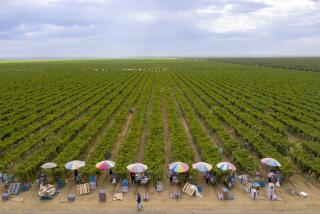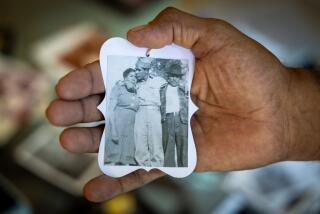Park Service considers protecting sites significant to Cesar Chavez’s life
Reporting from Delano, Calif. — Forty-one years ago, Cesar Chavez and local table grape growers gathered in a squat white building surrounded by vineyards and weeds on the western edge of this Central Valley community to sign contracts that brought large-scale unionization to agriculture for the first time in history.
Back then, it was the hub of a United Farm Workers complex known as 40 Acres, and “Huelga! Huelga!” — the Spanish word for “strike” — was the familiar battle cry of fieldworkers and their supporters around the world.
Today, the old hall is among 80 sites in California and Arizona under consideration for National Park Service protection because of their significance to the legendary organizer’s life and the turbulent history of the farm labor movement.
If all goes according to plan, some of them will become landmarks where people can ponder and debate the legacy of the diminutive, soft-spoken union activist who became a Gandhi-like figure to millions of Americans, especially Mexican Americans.
In addition to 40 Acres, other front-runners include the 187-acre Nuestra Señora Reina de La Paz retreat in the community of Keene, about 75 miles southeast of here, where Chavez was buried in a rose garden in 1993, and the 300-mile route of the UFW’s 1966 protest march from Delano to Sacramento. La Paz is also home to the National Chavez Center.
Then there is the Santa Rita Center, a building in the South Phoenix barrio known as El Campito, where Chavez fasted in 1972 to protest an Arizona law that limited farmworkers’ rights to conduct strikes and boycotts, and where he called for a recall of the state’s governor. That effort failed, but Chavez’s campaign rattled local politicians and attracted thousands of new supporters to his cause.
“We will make our final recommendations in November,” said Martha Crusius, project manager for the National Park Service’s Cesar Chavez Special Resources Study. “After that, it is up to Congress to make the final determination, a process which could take several months or years.”
Few places are as important as 40 Acres in Chavez legend. It is where he accepted a piece of bread from Ethel Kennedy in 1988, ending a 36-day fast to protest the use of agricultural pesticides. It is also where he fasted 25 days in 1968 for UFW members to maintain their commitment to the principles of nonviolence. That fast ended when Chavez shared bread with Sen. Robert F. Kennedy.
It is also the home of the Agbayani Retirement Village, the UFW’s response to the plight of elderly and displaced Filipino farmworkers.
Old-timers still walk the 40 Acres grounds with memories sharp.
Standing at the entrance to the union hall and surveying a grove of ash and pine trees planted decades ago by UFW supporters, Robert Bustos, 69, said: “This is where we assembled each morning to prepare to fight the most powerful industry in the region — agribusiness — with our hearts and picket signs. More people need to know and appreciate this place, which is still so alive for me.”
Richard Chavez, brother of Cesar and builder of the union hall, agreed. “40 Acres is at the top of my list to become absorbed by the National Park system because it is where the farmworkers’ movement took flight,” he said. “I hope it happens before the Obama administration’s [first] term runs out in 2013.”
In the meantime, a team led by Crusius has been visiting all of the sites regarded as nationally significant. On Friday, the group toured La Paz, the bucolic retreat where Chavez spent the last 22 years of his life amid oak trees along the lower slopes of the Tehachapi Mountains, between Bakersfield and the Mojave Desert.
Large photographs of Robert Kennedy and the Rev. Martin Luther King Jr. still dominate the walls of the recently renovated complex. Shelves in Chavez’s carefully preserved office are lined with personal mementos, religious icons, books — including his copies of Gandhi’s writings — and portraits of his two German shepherds, Boycott and Huelga.
“La Paz was Cesar’s spiritual harbor, a place to get away from the almost constant struggles in the fields and big cities,” said Marc Grossman, Chavez’s longtime aide and spokesman. “It was where he and his associates strategized their next moves, and gathered the energy needed to return to battle.”
More to Read
Sign up for Essential California
The most important California stories and recommendations in your inbox every morning.
You may occasionally receive promotional content from the Los Angeles Times.











